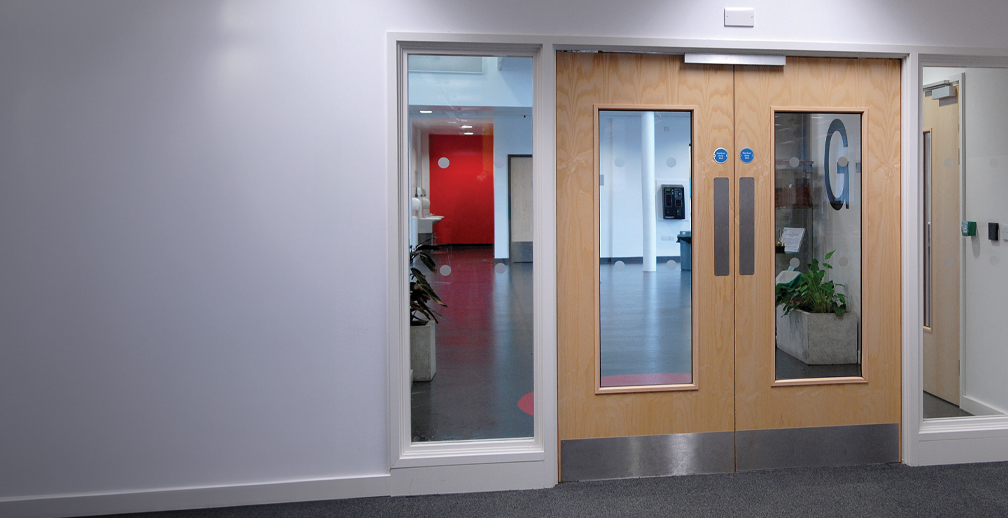Navigating fire safety glass: key considerations for optimal fire door systems
While fire safety glass is just one of the many components within a fire door system, choosing the right product is essential.
Read on as, Steve Goodburn, Business Development Director at Pyroguard explores some of the factors to keep in mind…

We all know the importance of taking a system approach to fire doors, with many individual components working together to provide the required level of fire protection, from the fixings and ironmongery (including hinges, locks and letter boxes) to the intumescent seals and fire safety glass. With so many fire safety glass products available on the market, there are a variety of factors that need to be considered in order to ensure you are making the best choice.
Wired or clear?
Historically, wired glass was the original glass of choice, commonly seen within fire doors and partitions in schools and social housing. While it can and does meet the required fire safety and impact resistance regulations, wired glass is fast becoming an obsolete product. It is also prone to various misconceptions, both by the general public and those within the industry itself. While the presence of metal wire may lead to people viewing it as a stronger product, or as an example of security glass, neither is the case; with wired glass often only having an impact rating of 3B3 to EN12600.
Instead, there are a host of new clear solutions that offer more, including enhanced aesthetics and performance. As well as achieving a higher fire safety classification, substituting wired for clear glass can also deliver greater impact resistance, acoustic ratings and light transmission values, providing added levels of performance on all levels.
When speed counts…
With some manufacturers potentially producing thousands of fire doors every week, the speed and availability of cuttable fire safety glass is critical. Any issue in the supply chain could lead to major delays further down the line. Consider looking for cuttable products that are manufactured here in the UK. As well as supporting the country’s economy, it can also mean shorter lead times for your business and a lower carbon footprint compared to those imported from overseas.
Size matters
The architectural and construction industries are in a constant state of evolution, with changing design trends and client demands leading to increasingly challenging fire safety applications. With glass a popular building material, it’s important to look for cuttable products that can deliver exceptional fire protection even at larger certified pane sizes and with a high tolerance to variations in glazing media.
While fire doors traditionally feature a rectangular strip of glass, it is increasingly common for doorsets to feature a side glazed partition or even an elegantly designed top-lite.
Timber and composite
While timber fire doors are perhaps the traditional choice, composite fire doors are also an increasingly popular solution for external applications, although not without their challenges.
Following the Grenfell disaster, there was a clear industry shift, looking instead for EI15 (Integrity & Insulation) fire safety glass, as opposed to E30 (Integrity). Composite fire doors can also present different complexities when testing the fire safety glass used, with a range of factors to consider, from the plastic edged glazing cassette to the door’s GRP exterior skin.
As a result, consider looking for a manufacturer who can provide tested and independently certified solutions for both timber and composite fire doors, offering a single source of supply.
Preparing for the future
As we look ahead to the future, it’s important to take a proactive approach and actively work to safeguard our businesses against potential industry shifts. Recently, there has been much discussion around a potential transition from British Standards (BS) to European Standards (EN). If actioned, this will mark a significant change for the industry, particularly within the timber door market, which has long relied on BS standards for testing.
While undoubtedly a positive step forward in terms of fire safety, the adoption of EN standards is renowned for posing more rigorous testing requirements. As a result, any shift from BS to EN could necessitate the redesign and retesting of numerous products, potentially leading to the temporary removal of door systems from the market during this transitional phase.
At Pyroguard, we’ve been testing to the EN standard for many years, including Pyroguard Advance, our new, high-performance fire safety glass. Certified for use across a wide range of steel and timber profiles, it provides EW classification with a fire resistance of 30 or 60 minutes, even at larger certified pane sizes. The Pyroguard Advance range also includes a multi-functional double-glazed fire safety glass that has been composite door approved, in accordance with EN1634-1 for external doorsets.
For more information, please contact us.
